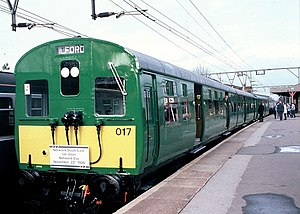British Rail Class 306
| British Rail Class 306 | |
|---|---|

The preserved Class 306 train (unit 017) as seen on the launch day of Network SouthEast. This view also shows the carriage which was not modified when the trains were converted from the DC to the AC power supply system.
|
|
| In service | 1949 - 1981 |
| Manufacturer | Metro Cammell and BRCW |
| Constructed | 1949 |
| Refurbishment | 1960-1961 |
| Number built | 92 trainsets |
| Formation |
|
| Design code | AM6 |
| Fleet numbers |
|
| Capacity |
|
| Operator(s) | British Rail |
| Depot(s) | Ilford |
| Line(s) served | Shenfield Line |
| Specifications | |
| Train length | 177 ft 7 in (54.13 m) |
| Car length |
|
| Width | 9 ft 3 in (2.82 m) |
| Height | 13 ft 1 in (3.99 m) |
| Doors | Bi-parting sliding |
| Articulated sections | 3 |
| Maximum speed | 75 mph (121 km/h) |
| Weight |
|
| Traction motors | 4 × EE 504 |
| Power output | 4 × 210 hp (160 kW) |
| Electric system(s) |
|
| Current collection method | Pantograph |
| UIC classification | Bo'Bo'+2'2'+2'2' |
| Bogies | Thompson |
| Braking system(s) | Air (EP/Auto) |
| Coupling system | Screw |
| Multiple working | Within class |
| Track gauge | 4 ft 8 1⁄2 in (1,435 mm) |
The British Rail Class 306 was a type of electric multiple unit (EMU) introduced in 1949. It consisted of 92 three-car trains which were used on newly electrified suburban lines between Shenfield and London Liverpool Street.
Class 306 trains were built to a pre-World War II LNER design by Metro Cammell and Birmingham RCW, and were equipped with English Electric traction equipment. Each carriage featured two sets of twin air-operated sliding passenger doors, which could be opened by either the guard or the passengers using the passenger operated buttons fitted next to them, on both the outside and inside of the trains.
When first built the trains were energised at 1,500 V direct current (DC) which was sourced from overhead wires, being collected by a diamond pantograph located above the cab on the Motor Brake Second Open (MBSO) vehicle.
In the early 1960s the overhead wires were re-energised at 25,000 V alternating current (AC) (and 6,250 V AC in the London area) and the trains were rebuilt to operate using this very different electrical system. This entailed the fitting of a transformer and rectifier unit, which were located on the underframe between the bogies of the intermediate carriage. At the same time the location of the pantograph was moved to this carriage as well. Because this reduced the headroom inside the train, the guards' compartment was relocated to be directly below the pantograph, which was replaced by the more modern Stone Faiveley AMBR pantograph design. The trains were then re-numbered 001-092 with the last two digits of each carriage number (previously numbered in the LNER coaching series) the same as the unit number.
...
Wikipedia
